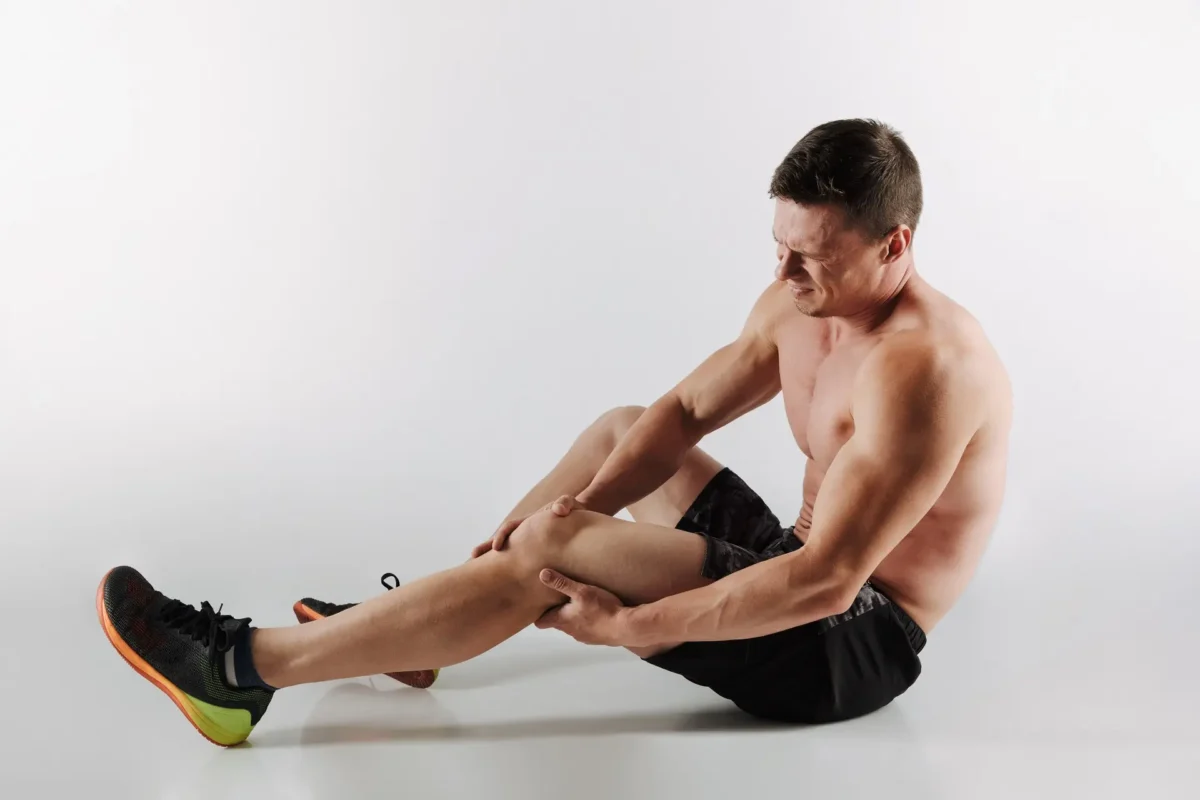You’ve likely experienced muscle soreness after stretching, but overstretching can lead to serious injuries that impact your flexibility and strength.
When you stretch beyond your body’s natural limits, you risk damaging muscles, tendons, and ligaments. Understanding proper stretching techniques and recognizing warning signs can help prevent these injuries.
Knowing how to respond when they occur can ensure a faster recovery and better long-term outcomes.
Why Am I Sore From Stretching?
You feel sore from stretching because muscle fibers experience tiny tears when pushed beyond normal limits. This strain triggers delayed onset muscle soreness (DOMS), which appears 24–48 hours after stretching.
Improper technique or lack of preparation increases the risk, but the process also builds flexibility over time.
Several factors influence post-stretch soreness:
- Trying new stretching methods
- Holding stretches too long
- Stretching too frequently
- Not warming up properly
- Using incorrect form
- Pushing too hard, too quickly
What Are the Risks of Overstretching?
Overstretching risks include muscle tears, ligament and tendon damage, and joint instability. Nerve compression may cause tingling or shooting pain.
Continued overstretching leads to chronic pain and joint degeneration. Improve flexibility safely by stretching within limits to protect tissues and preserve structural integrity.
- Muscle Injuries: Pushing muscles beyond their limits can cause tears in the fibers, resulting in soreness, weakness, or even complete tears.
- Ligament and Tendon Damage: Overstretching ligaments and tendons may cause inflammation and pain.
- Joint Instability: Overstretched muscles and ligaments lose stability, raising the risk of injuries and dislocations.
- Nerve Compression: Excessive stretching can press on nerves, leading to numbness, tingling, or sharp pain.
- Chronic Pain: Repeated overstretching can cause lasting pain as tissues struggle to repair and adapt.
- Joint Degeneration: Long-term overstretching may contribute to joint wear and the development of arthritis.
- Reduced Mobility: Overstretching can weaken muscle tone and function, thereby limiting movement and increasing the risk of injury.
Can I Stretch Too Much?

You can stretch too much if you push beyond your joints’ normal range of motion. Overstretching causes joint laxity, instability, and tissue damage.
Risks increase when stretching is misused to treat pain or when mobility training replaces balanced fitness. Prevent injury by avoiding forced stretches and combining flexibility with strength and cardio.
⭐Physical therapist Katie Sun Worrall explains that overstretching occurs when you push beyond your joints’ normal range of motion, which can lead to joint laxity (excessive looseness in joints) and instability.
Two common scenarios put you at risk for overstretching.
First, you might incorrectly use stretching to treat muscle pain or tightness that requires different interventions.
Second, you could become overly focused on mobility training while neglecting other essential fitness components.
How To Prevent Overstretching?
Preventing overstretching requires a careful balance of technique and self-awareness during your stretching routine.
To maintain healthy joint flexibility, focus on proper form and gradual progression rather than forcing your range of motion.
- Know your limits: Only stretch within a comfortable range.
- Use gentle intensity: Avoid forcing your stretches too hard.
- Keep it brief: Don’t hold stretches for too long.
- Warm up first: Stretch only after your muscles are adequately warmed up.
- Stay hydrated: Proper hydration can loosen you up.
Start with a thorough warm-up that includes 5-10 minutes of light cardio to increase blood flow. You’ll want to incorporate dynamic stretches (controlled movement-based stretches) before moving into static holds.
Never bounce or pulse in your stretches, as this can strain your joints. Stay within your body’s natural limits – if you feel pain rather than mild tension, you’ve gone too far.
Remember to hydrate and avoid stretching when you’re fatigued properly.
Also, make sure you’re wearing appropriate footwear and exercise gear to support proper form throughout your stretching routine.
How Should I Treat Strains & Sprains from Overstretching?
When you’ve overstretched a muscle or joint, prompt action can help minimize damage and accelerate recovery.
The most effective treatment follows the R.I.C.E. method, which protects the muscle-tendon unit and maintains proper joint lubrication during the healing process.
- Rest: Start by resting the injured area.
- Ice: Apply ice or cold packs as soon as possible. Use 15–20 minutes on, followed by 15–20 minutes off, for 48–72 hours after the injury.
- Compress: Wrap the injured area with an elastic bandage, but not too tightly. Loosen if swelling increases pressure.
- Elevate: Keep the injured area raised above heart level, including while icing and sleeping.
First, rest immediately and stop all activity. Apply ice packs for 15-20 minutes at a time, alternating with equal rest periods for up to 72 hours.
Next, compress the area with an elastic bandage, being careful not to wrap too tightly. Then, elevate the injured body part above your heart, even while sleeping.
For pain management, you can take over-the-counter pain medication like acetaminophen or ibuprofen.
If you don’t see improvement after following R.I.C.E. for several days, consult your doctor, as you may need additional treatment.
Why Stretching Is Important?
Regular stretching plays an essential role in maintaining your body’s overall health and function. The importance of stretching extends beyond simple flexibility – it’s vital for maintaining a full range of motion in your joints and preventing conditions such as joint hypermobility syndrome and muscular dystrophy.
When you sit for long periods, muscles become tight and shortened, particularly in your legs and back.
Without proper stretching, you’re at higher risk for muscle strain and joint pain during physical activities.
Your muscles need to remain long and flexible to support proper joint function and movement.
Focus on stretching key muscle groups, mainly:
- Lower extremities
- Calves and hamstrings
- Hip flexors and quadriceps
- Shoulders and neck
- Lower back
Aim to stretch these areas at least three to four times a week to maintain optimal muscle health.
What Are the Benefits of Stretching?
The benefits of stretching include improved flexibility, increased range of motion, and greater joint stability.
Regular stretching enhances soft tissue elasticity, protects muscles and joints, and reduces back pain.
Stretching also relieves muscle tension, supports efficient movement, and boosts overall performance in both daily activities and exercise.
This enhanced function can improve your athletic performance while reducing your risk of injury.
- Soft Tissue Elasticity: Soft tissues (tendons, ligaments, muscles) control and limit the range of motion, keeping joints like the shoulder stable.
- Flexibility Factors: Flexibility is a joint’s comfortable range of motion. Tightness, imbalances, past injuries, scar tissue, or extra muscle/fat can limit movement.
- Optimal Flexibility: Flexibility isn’t about extreme bendiness—it’s about maintaining a comfortable, pain-free range of motion suited to your body and goals. Genetics sets limits via joint shape and tissue properties.
- Joint Muscle Protection: Stretching protects joints and muscles without forcing injury—proper technique prevents overstretching and damage to collagen/muscle.
- Increase Flexibility: Regular stretching enhances flexibility, range of motion, posture, and efficiency in daily activities and sports, while reducing the risk of injury and back pain.
- Boost Circulation: Stretching increases blood flow to muscles, reduces stress, delivers oxygen, aids recovery, and prevents soreness. Diet can also support circulation.
- Enhance Mood: Flexibility routines can be meditative, reduce distractions, improve emotional processing, and promote presence, acceptance, and self-forgiveness.
- Balance Your Body: Stretching Enhances Posture and Body Balance. Focusing extra attention on the injured or less flexible side prevents compensation and reduces the risk of injury.
Preventing Future Soreness
Use gentle movements to stretch your muscles. Hold each stretch for 20 to 30 seconds. Avoid bouncing while stretching. Bouncing can cause tiny tears in muscles. Warm up before stretching to increase blood flow. Cold muscles are more prone to injury.
Stop if you feel any sharp pain. Stretching should not hurt. Listen to your body signals. Do not push too hard. Overstretching can cause damage. Take breaks if you feel tired. Rest helps muscles recover. Pay attention to your body’s limits.
When To Seek Professional Help
Chronic pain is different from regular soreness. It lasts for weeks or even months. If pain doesn’t go away, it could be a sign of a problem. Watch for swelling or bruising. These might mean a serious injury. Pain that interrupts daily life is a big warning. It’s best to ask a doctor when pain is severe.
Physical therapists can help reduce pain. They use exercises and treatments. This helps the body heal and get stronger. Physical therapy can help avoid future injuries. Sometimes, special equipment is used in therapy. This makes sure the body heals correctly. Rehabilitation programs are made for each person’s needs.
To Wrap It All Up
As the old saying goes, “An ounce of prevention is worth a pound of cure.” You’ll get the most from your stretching routine by listening to your body and following proper techniques.
Remember to warm up first, use dynamic stretches before static ones, and never push past your comfort zone.
If you do experience pain, don’t hesitate to use R.I.C.E. and seek medical help when needed. Safe stretching leads to improved flexibility and a reduced risk of injuries.
FAQs
Is It Normal To Be Sore After Stretching?
Yes, it is normal to feel mild soreness after stretching, especially if you are new or pushed beyond your usual range. This soreness comes from small muscle fiber stress. However, sharp or lasting pain is not normal and may indicate overstretching or injury.
What Are the Common Risks of Overstretching?
The common risks of overstretching include muscle strains, ligament sprains, and joint instability. Overstretching weakens tissues, reducing strength and stability. Severe cases may lead to microtears or long-term flexibility issues.
Should You Still Stretch If You’re Sore?
You can stretch if you are sore, but keep it light and gentle. Stretching improves blood flow and reduces stiffness, aiding recovery. Avoid deep or aggressive stretches, as they may worsen soreness or cause injury.
How To Recover From Overstretching?
Recover from overstretching by resting the affected muscles, applying ice for 15–20 minutes, and using light compression. Gradually return to movement with gentle stretches and mobility work once pain subsides. Severe cases may require physical therapy for full recovery.
How Do You Know If You Are Overstretching?
You know you are overstretching if you feel sharp pain, joint instability, or lingering soreness beyond 24–48 hours. Signs also include reduced strength and limited range of motion. Mild discomfort is normal, but severe pain signals overstretching.
What Are The Most Common Injuries Caused by Overstretching?
The most common injuries caused by overstretching are hamstring strains, groin pulls, and lower back injuries. Overstretching can also damage ligaments, leading to sprains or joint instability. These injuries occur when tissues are forced beyond their natural limits.











